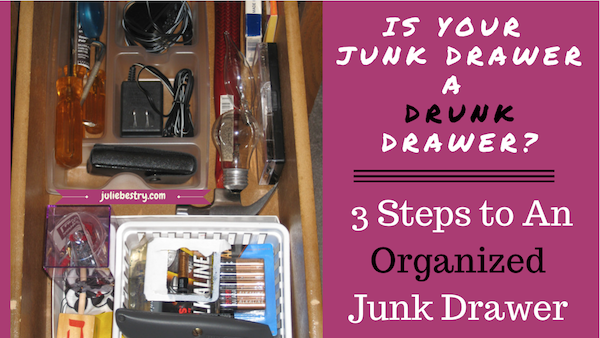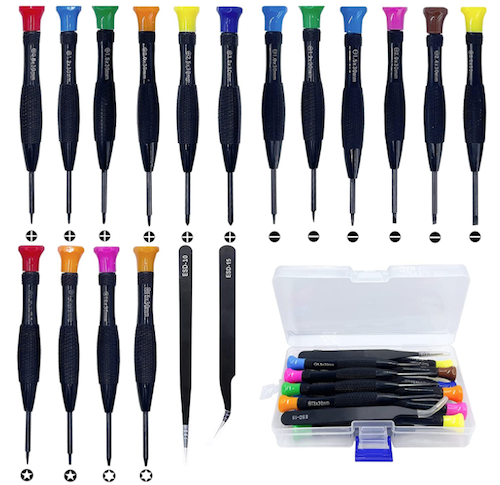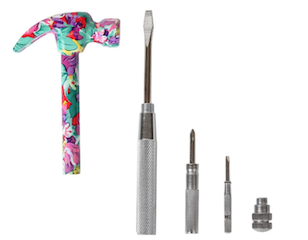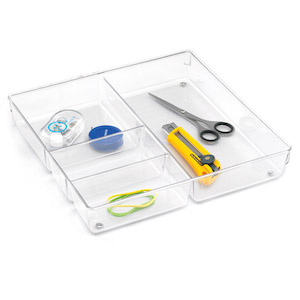[This post originally appeared on January 8, 2019, and has been updated with additional material as of October 4, 2021.]

One of my clients refers to her kitchen junk drawer the “Drunk Drawer.”
I don’t drink, so I thought I was missing a pop culture reference. She said that now that we’ve been working together to help her get her life back in order after a few tumultuous years, most of her life is planned out to the nearest detail — organized, categorized, contained. But, on the rare occasion that someone puts a margarita in her hand, especially after a stressful time at work, and she has the opportunity to let her hair down, everything flows freely.
My client notes that with a margarita (or a few) in hand, she says what she wants, she dances to her own drummer, and she gives herself permission to accept that not everything makes sense. Similarly, my client sees that her junk drawer is the one area in her house where she lets the wackiness take over, categories intermingle, and nothing makes sense.
I was reminded of my client’s story when I was approached by Katina Hazimihalis of Dumpsters.com for the Start Fresh: Take the 30-day Decluttering Challenge. (Definitely check it out!) They asked for my advice for Day 7, earmarked as the day of their challenge to “Declutter the Kitchen Junk Drawer.”
 Longtime readers of Paper Doll know that I can never give only a little bit of advice, so there’s a lot that didn’t make it into that post. So, now it’s all here for you!
Longtime readers of Paper Doll know that I can never give only a little bit of advice, so there’s a lot that didn’t make it into that post. So, now it’s all here for you!
WHAT’S THE DEAL WITH THE JUNK DRAWER?
Most of the things in a junk drawer aren’t junk. They just tend to be far from their friends in similar categories — the loose change that never makes it to the wallet, the tools that haven’t found their way back to the toolbox, all those random things we want to keep, but we don’t want to take the time to think about where they belong.
Seth Godin says, “The junk drawer is the enemy of understanding.” I have to agree. If you can’t name it, you can’t fathom it.
With paper, “miscellaneous” is the enemy. Is it financial, legal, medical, household, or personal? Is it action paper or reference paper?
With clothing, it’s either underwear, outerwear, or what you wear! You can subdivide into shirts, pants, dresses, etc., and onward to sleeve length or color or season, but there’s still a basic way to start breaking things down.
Categorically, things need to belong somewhere — is it fish or fowl? Animal, vegetable, or mineral? Ginger or Mary Ann? If you can name it, you can put it into place.
But unlike paper or clothing, not everything has just one home. Some things have a main home and a vacation home — that’s the junk drawer. Yes, you should have a home first aid kit, but it’s helpful to keep a few Band-aids in the kitchen. Yes, most of your office supplies belong in your home office or at your desk, but sometimes you need to grab a highlighter to make sense of the recipe you’re making.
At its best, the household junk drawer can be a miniature subset of categories found around the house. At its worse, however, it’s drunk. It’s sloppy, it makes no sense, and it leads you down a path of regret. Let’s fix that!
WHAT’S THE FIRST STEP TO ORGANIZING A JUNK DRAWER?
Empty that junk drawer. Dump the whole thing out.
It’s rare to hear a professional organizer advise emptying everything out of any space. Usually, we focus on handling one shelf or one category at a time. That’s because the last thing you want to do is get ninety minutes into a closet overhaul and have to pick up your children from school, leaving you with an unusable bedroom and a huge headache.
However, there are two reasons why a complete dump-out makes sense with a drunk junk drawer. First, junk drawers are small. Other than a wallet, purse, or glove compartment, I’d be hard-pressed to find a smaller space that requires concerted attention.
Second, approaching a junk drawer too delicately usually means nothing ever gets completed. People pull out one item at a time and make a few decisions, put a few things back when they decide to keep them, and never quite get around to making decisions about everything. Instead, the best thing to do is to remove everything from the drawer.
Because most junk drawers are in kitchens, what often works is to put a large towel down on the countertop or kitchen table (to prevent scratches). Plop everything down together. Slowly move things to the outer edges of the towel, as if you were searching for a Canadian penny amid all the coins you’ve shaken out of your piggy bank.
Grab the low-hanging fruit first. Remove gum, candy, soy sauce or hot sauce packets, or really anything edible and move to a “snack” box or food storage container on one of the shelves of your kitchen or pantry. Keep sticky, melty, or bug-friendly edibles out of the junk drawer.
Select one item at a time and ask yourself a few questions:
- Is it broken, expired, dried out (like pens or old wipes), or icky? Toss it out!
- Do you ever really use it? If not, you might toss it or donate it.
- Do you find yourself using it often enough that it really needs to be in the kitchen (or whatever room you keep your junk drawer)? If not, move it to a part of the house where it better fits with a category of items already kept elsewhere, like tools or office supplies.
- Do you need this many of whatever it is? Keep your favorite, keep the best, keep the one you’d grab if you needed it. Set the excess free (from the drawer) and either donate or move to a more appropriate place in your home.
Remember, if you don’t use it often, don’t let it take up the valuable prime real estate in your drawer!
NEXT, MAKE SENSE OUT OF THE CATEGORIES
At first glance, it may seem like everything in the junk drawer belongs to the miscellaneous category, but with patience, you’ll start seeing patterns.
Categorize the items into little areas/zones on the counter or table so you get a sense of how many of each thing you have. If you have duplicates, triplicates, or more, you may want to keep one version handy in the drawer, but move the remainder elsewhere, in your own mini-mall of “when I need them” supplies.
Ask yourself, what does the item DO? What is it for? Some category examples:
Batteries — Keep a small supply of the most commonly (and urgently) needed (like AA and AAA). Move the rest, plus whatever other sizes (9 volt, C and D, and smaller batteries for hearing aids, watches, and medical devices) to one divided container (like a tackle box) elsewhere in the house, like in a cabinet or on a shelf in the laundry room, utility room, or basement.
Duplicate keys — Use key cap tags/covers or labels to identify what the keys fit and keep all keys in one container.
Eyeglass Supplies — like spare reading glasses, mini bottles of eyeglass cleaner, a microfiber cloth, tiny magnetic screwdrivers for repairing glasses

Electronics — like chargers, plugs, adapters, power banks, or any electrical doo-dads that you need to get your hands on regularly. If you’ve got a charger you only use with your old video camera, store it with the camera case, not taking up space in your new-to-sobriety junk drawer.
Loose change — Store your change in a small-to-medium-sized lidded jar, and whenever you come across any loose change in the house, drop it in. When it’s full, take to your bank or donate it to charity. Hate rolling your coins? Hand it off to a responsible ten-year-old, or consider Coinstar.

Image by PublicDomainPictures from Pixabay
Many grocery stores and retail lobbies have Coinstar kiosks; you just dump your coins in, and (for a hefty 11.9% fee) the machine will count your money and give you four great alternatives. You can:
- Get back cash in the form of paper money.
- Add cash to your Amazon balance (and learn more about how it works on the Amazon side, if you’d like to shop without using a debit or credit card)
- Buy an eGift card (and bypass the coin-counting fee) — Current retail gift card options include Amazon, Apple, Cabela’s, GameStop, The Gap, Hotels.com, iHop, Krispy Kreme (whoohoo!), Outback, Sephora, Starbucks, and many other retail and dining locations.
- Donate to charity (including the American Red Cross, Children’s Miracle Network Hospitals, Feeding America, the Leukemia & Lymphoma Society, Make-a-Wish, NAACP, the Humane Society, UNICEF, United Way, and the World Wildlife Federation. (See? By organizing, you can do well for yourself and do good for others!)
Apparently you can also purchase Bitcoin through Coinstar, but it’s Paper Doll‘s policy never to recommend options that I can’t explain.
Office supplies — Subdivide this larger category into smaller office supply categories by function:
- things that put stuff together (stapler, tape, binder clips)
- things that pull things apart (scissors, staple remover, X-Acto knife or box cutter), assuming the drawer is safe from the hands of curious little ones
- things with which to write (pens, pencils, highlighters)
- things on which to write (sticky note pads, notepads) — but, in general, try to keep documents and loose papers out of the junk drawer. If you’re keeping takeout menus, coupons, contact info, etc., in that general area, use a file riser and keep a few file folders for the purpose. Paper should live upright, not squished in a tiny drawer.
If you have a home office or homework zone elsewhere in the house, keep these supplies to a minimum in the junk drawer. If you have a kitchen desk (built-in or otherwise), move the office supplies to the desk drawer.
Move any papers out of the drawer and into a desktop file box or a few three-ring binders designated for take-out menus, house-of-worship or homeowner’s association directories, and school reference papers.
Things that burn or light — birthday candles, matches/lighters, flashlights (but, as with sharp doo-dads, do consider whether these need to be kept elsewhere if you have tiny humans in the house)
Tools — People have a habit of getting a tool out of the toolkit for a task and never putting that tool away, tossing it in the junk drawer instead. Homes are much more efficient if you maintain a real toolkit with everything you need to run your house smoothly. (If you have an actual house or do a lot of DIY, get one pre-made; most Grandpas would recommend something by Craftsman. Or assemble one that fits your needs from recommendations online, like this Pioneer Woman post on building a starter tool kit.)
Then, just keep a small section of your junk drawer for a multi-tool (like a Leatherman), a few short-handled Phillips-head and flat-head screwdrivers (and a Robertson* screwdriver, if you’re in Canada), measuring tape, and a small hammer. Because, come on, is your house SO big that walking to the toolkit is going to exhaust you?
Note: If you find yourself doing a lot of tiny repairs, keep all of your tools in your main toolkit, but get any inexpensive hammer with lots of tiny screwdrivers nesting inside.


NOW, CONTAIN YOUR CATEGORIES
Once you divide everything into sub (and sub-sub) categories as described above, you’ll have a sense of what you own, and how much of it you’ve been trying to keep. Now it’s time to get creative and figure out how you are going to make it all fit together.
Divide, contain, and conquer!
But before you start moving things into their new, more organized homes, wipe down the interior of your drawer with a damp cloth.
If more than about one-quarter of the drawer is filled with just one category, then it’s time to move that category out of the junk drawer. Find that category its own dedicated home, in a box or bin that contains all of that category, whether on a shelf in the pantry, laundry room, or wherever is closest to where you use it most often.
Next, use padded, non-slip counter or shelf liners with a bit of rubbery “grip” to cover the bottom of the drawer. This will keep items from sliding around when the drawer opens and closes, and also prevent squeaking.
Use drawer dividers and/or small containers to corral each individual category. There are a variety of options depending on how many items you have in each category, how large they are, and how large the interior of your drawer is (in terms of height and depth). Consider the following options:
Inexpensive, plastic, flat-bottom baskets in multiple lengths/widths. You can arrange them as if you were playing a game of Tetris! (You can use lidded containers, like snap-closed pencil cases designed for elementary school students, but just the tiny added labor of having to open and close lids to retrieve and later put things away might dissuade you from staying organized and lead you to leaving things out on the counter or just tossed in the drawer.)
For example, Mainstays’ line of plastic storage baskets can be found at Walmart, various dollar stores, and online. I particularly like the narrow ones for writing implements, screwdrivers, and scissors.
Wider rectangular Mainstay baskets are better for notepads, batteries, and anything where you’re keeping quite a few things grouped together.
There are similar options if you prefer brighter colored baskets, and local or teaching supply stores tend to have cheerier baskets.
Ice cube trays work well for corralling very small items; mini-muffin trays can be great for keeping magnets from getting loose.
Sectioned drawer dividers can be found in a variety of styles in home goods stores. For example:
KD Organizers Deep Drawer Organizing Trays
Container Store Linus 4-Section Drawer Organizer
 Mesh desk drawer organizers from office supply stores are usually inexpensive, low-key attractive, and work well when you want to buy just one thing. This Rolodex Deep Desk Drawer Organizer is simple, but gets the job done.
Mesh desk drawer organizers from office supply stores are usually inexpensive, low-key attractive, and work well when you want to buy just one thing. This Rolodex Deep Desk Drawer Organizer is simple, but gets the job done.
Expandable cutlery drawer inserts are also good alternatives; you may already even have extras in the house. Just be sure to use the ones that with rectangular compartments, and not those that are shaped like spoons or forks. Otherwise, most things won’t fit properly.
THE FINAL WORD
An occasional margarita on the beach can be fun, but you wouldn’t want to replace your morning coffee with it. Similarly, you don’t want your junk drawer to get too wild. Make time periodically to maintain your more orderly junk drawer and keep it from becoming a drunk drawer.
*Thanks to my fabulous former professional organizing colleague, Jackie Hollywood Brown (blogger at Canadian Army Wife and virtual assistant extraordinaire at Productively Organized), for introducing me to the concept of those nifty, square Robertson screwdrivers. They rank with Tim Horton’s, poutine, and Kim’s Convenience as just a few of the fabulous things our neighbors to the north enjoy under the radar. Please note that Jackie, herself, serves clients in the U.S. as well, so if you’re in the market for a VA, she’s the bee’s knees!
Disclosure: Some of the links above are affiliate links, and I may get a small remuneration (at no additional cost to you) if you make a purchase after clicking through to the resulting pages. The opinions, as always, are my own. (Seriously, who else would claim them?) For more information regarding how Best Results Organizing handles affiliate links, please see the affiliate section of the site’s Privacy Policy.
Like this:
Like Loading...

 Longtime readers of Paper Doll know that I can never give only a little bit of advice, so there’s a lot that didn’t make it into that post. So, now it’s all here for you!
Longtime readers of Paper Doll know that I can never give only a little bit of advice, so there’s a lot that didn’t make it into that post. So, now it’s all here for you!








 Mesh desk drawer organizers from office supply stores are usually inexpensive, low-key attractive, and work well when you want to buy just one thing. This
Mesh desk drawer organizers from office supply stores are usually inexpensive, low-key attractive, and work well when you want to buy just one thing. This 




Love this post! Another thing to keep in mind is limiting what you keep. Yes, you probably need elastics, but do you really need 50 of them?
It depends — hair elastics or those tiny rubber bands for braces? 😉
Organizing junk drawers is one of my favorite things to do. It’s like going on an excavation because you never know what you’ll find. It also is a relatively small area of chaos that can be tamed easily. Overall, it’s a matter of putting “like with like.” And that can look different depending on how you think, so something to keep in mind. Inserting compartments, as you suggested makes a huge difference in for keeping the sections organized and for being able to find things easily.
Your post includes so many of the odd items that end up in our junk drawers – birthday candles, eyeglass accessories. It’s amazing how a junk drawer could be filled with such similar things from home to home!
Great post.
Thanks so much! I think we tend to have locations for all of our major categories, which leaves all the odd-lot “Misfit Toys” randomly together.
I have always thought everyone should have TWO junk drawers. One organized, as you describe — more of a UTILITY drawer than a JUNK drawer — and another to sweep things into when company comes, and to put stuff you don’t know what to do with…yet…until, of course, it starts to overflow. At which time I defer to my “Don’t let your containers overflow!” blog post. And if/when I (finally) write about the two junk drawers, I can now link to your post for the “organized” part. I love the way you put it: “At its best, the household junk drawer can be a miniature subset of categories found around the house.”
What a great idea, to let yourself have the freedom of a “tipsy” junk drawer but a sober utility drawer. I’ll look forward to YOUR blog post, Hazel!
I bought some plastic drawer dividers from the dollar store. They work great for dividing things up a bit. I am sure you could also get nicer wooden ones if you desired. My two drawers in my kitchen could use a little tlc. Great post. Love the drunk drawers. Lol
I’m with you, Kim. I think that if something lives hidden inside a drawer, there’s no need to spend more than $5-$10 to keep it sorted out.
I’m resonating with the idea of a “vacation home.” This is exactly what happens in the junk drawer! I have the eyeglass screwdriver, as well as a Phillips head one because I use it enough that I don’t want to have to go to the basement and hunt it down.
One challenge in the junk drawer can be that it is very shallow. There are only a couple of solutions for drawers that are under 2in in depth, but they are well worth it, even if they aren’t pretty.
Love that Linus 4-section insert!
That IS a shallow drawer. Someone needs to make more drawer solutions for that size!
My junk drawer is actually deeper than I need it to be, making it too tempting to add another layer of items. You can see the overhead view of it in the post cover photo.
For the longest time, I’ve really wanted to shout from the mountain tops YOU DON’T NEED A JUNK DRAWER! But I’m realizing that not everyone lives on a single floor with the room where things actually belong only a few steps away. Seems like a good “junk” drawer is more of a short cut to access things that you commonly use, but aren’t strictly “kitchen” items.
Phaedra, that’s exactly it. As Hazel acknowledged, there’s a crossover between a junk drawer and a utility drawer. If you’ve got a 4BR/3BA house, with the home office upstairs, you’re not going to want to head all the way upstairs to get a sticky note pad, and if it’s winter, you’re not going to want to head to the garage to just get a screwdriver. A junk drawer, when it’s not “drunk,” is a mini-mini version of other “stations” further away from the house.
Great tip about ice cube trays for tiny objects! This is a great article and very thorough. Thanks for all the great advice!
You’re so sweet! Thank you. And the neat thing about ice cube trays is that they now come in different shapes and sizes; the ones for long, narrow ice (to fit into water bottles) are great for corralling small items that have more length than width (like golf pencils, some diabetes and other medical supplies, tiny screwdrivers, etc.)
One day soonish, I’ll be linking to this excellent post for my forthcoming post about how every room in your house needs a junk drawer. No, really.
I like that concept. It reminds me that there are several drawers in my mother’s house that are just empty, because everything already has a home. But in rooms where there’s a small subset of categories (like the bedside table) it makes sense!